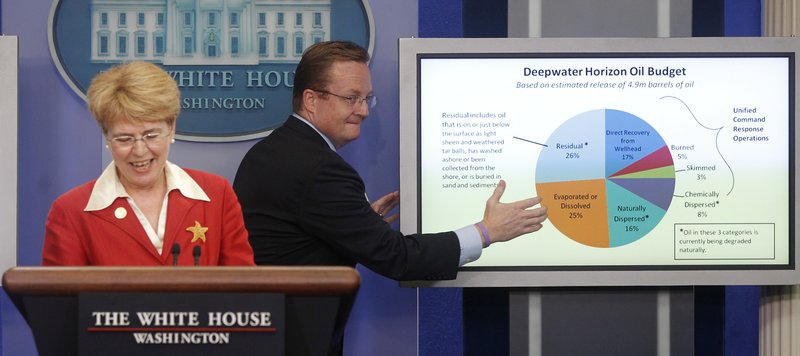NEW ORLEANS – In the end, it was a crush of mud that finally plugged the blown-out well in the Gulf of Mexico, three months after the offshore drilling rig explosion that unleashed a gusher of oil and a summer of misery along the Gulf Coast.
The government stopped just short of pronouncing the well dead Wednesday, cautioning that cement and mud must still be pumped in from the bottom to seal it off for good.
President Obama declared that the battle to contain one of the world’s worst oil spills is “finally close to coming to an end.”
Yet after months of living with lost income, fouled shorelines and dying wildlife, some Gulf Coast residents weren’t so sure.
“I don’t think we’ve finished with this,” said 59-year-old Harry “Cho-cho” Cheramie, who grew up in Grand Isle, La. “We haven’t really started to deal with it yet. We don’t know what effect it’s going to have on our seafood in the long run.”
Still, it appeared there might finally be an end in sight to the disaster that closed vast stretches of fishing areas, interrupted the usually lucrative tourist season, and cost BP’s CEO his job and the company’s shareholders billions of dollars.
BP PLC said 2,300 barrels of mud forced down the well overnight — an operation called a “static kill” — had pushed the crude back down to its source for the first time since the Deepwater Horizon rig exploded off Louisiana on April 20. The explosion killed 11 workers and began the spill that sent tar balls washing onto beaches and oil oozing into delicate coastal marshes.
Later Wednesday night, National Incident Commander Thad Allen said he approved BP’s plan to begin forcing cement down the well, as long as it didn’t delay work on the relief well. BP officials said they planned to begin pumping cement today.
And there was more seemingly good news: A National Oceanic and Atmospheric Administration report released Wednesday claimed that only about 30 percent of the spilled oil remains in the Gulf and is degrading quickly.
The government’s accounting of the spill, called an “oil budget,” appeared to answer the most troubling question: Of the 4.9 million barrels (205.8 million gallons) that poured out of the well, only 827,000 barrels were siphoned to vessels on the surface. Where did the rest of it go?
Where there had been mystery, now there was a pie chart.
It showed that 5 percent of the total oil had been burned and that 3 percent had been skimmed off the surface. An additional 25 percent had evaporated or dissolved. Another 25 percent had been “dispersed” — broken into tiny droplets by chemicals or by the force of being blasted out of the well.
But some independent experts said they were concerned that the government’s method of estimating the amount was too simple for such a complex spill, and even government scientists cautioned the rosy numbers do not mean the Gulf is out of harm’s way.
Some outside scientists went further: In a situation in which many facts remain murky, they said, the government seemed to have used interpretations that made the Gulf — and the federal efforts to save it — look as good as possible.
“There’s a lot of … smoke and mirrors in this report, I’m afraid,” said Ian MacDonald, a professor of biological oceanography at Florida State University. “It seems very reassuring, but the data aren’t there to actually bear out the assurances that were made.”
Even if the government is right and only 26 percent of the oil is left, that would still be 1.3 million barrels, five times the oil spilled from the Exxon Valdez in 1989.
The containment effort — and the cleanup — aren’t finished, either. Federal officials said they won’t declare complete victory until they pump in mud and cement from the bottom to seal the well, a procedure that might not be done for weeks.
“We’re in a good place today, but we want to get it permanent over the near term, whether that’s days or weeks,” said Kent Wells, BP senior vice president, who repeatedly and pointedly avoided saying the static kill had finished the job. Asked when he will be able to say the well is dead, he replied: “I’m looking forward to that day.”
Charter boat captain Randy Boggs, of Orange Beach, Ala., said he has a hard time believing BP’s claims of success with the static kill, and similarly dismissed the idea that only a quarter of the oil remains in the Gulf.
“There are still boats out there every day working, finding turtles with oil on them and seeing grass lines with oil in it,” said Boggs, 45. “Certainly all the oil isn’t accounted for. There are millions of pounds of tar balls and oil on the bottom.”
Even politicians expressed concern that BP and the federal government will need to stay focused on the cleanup and long-term monitoring of the Gulf’s marine life.
“This is a positive step,” said Louisiana Gov. Bobby Jindal, “But this crisis is not over for Louisiana until the well is permanently capped and our coasts and wetlands are fully restored to their pre-spill status and our people can resume their way of life.”
The Washington Post contributed to this report.
Copy the Story Link
Send questions/comments to the editors.



Success. Please wait for the page to reload. If the page does not reload within 5 seconds, please refresh the page.
Enter your email and password to access comments.
Hi, to comment on stories you must . This profile is in addition to your subscription and website login.
Already have a commenting profile? .
Invalid username/password.
Please check your email to confirm and complete your registration.
Only subscribers are eligible to post comments. Please subscribe or login first for digital access. Here’s why.
Use the form below to reset your password. When you've submitted your account email, we will send an email with a reset code.